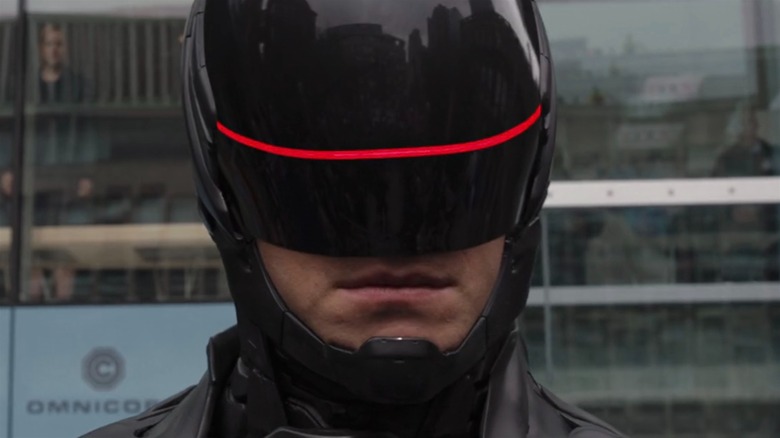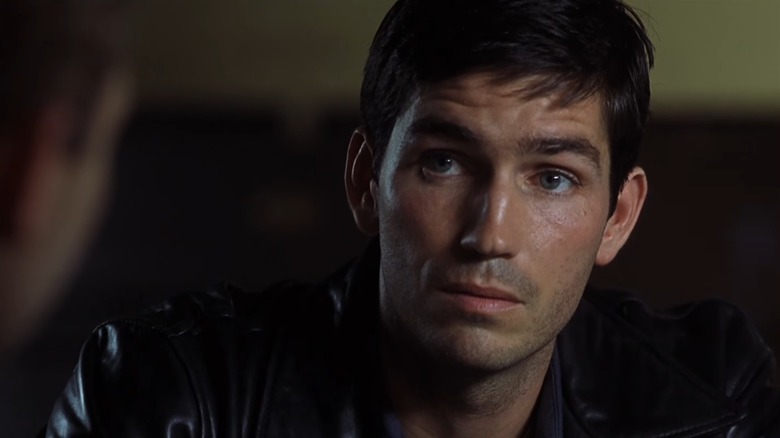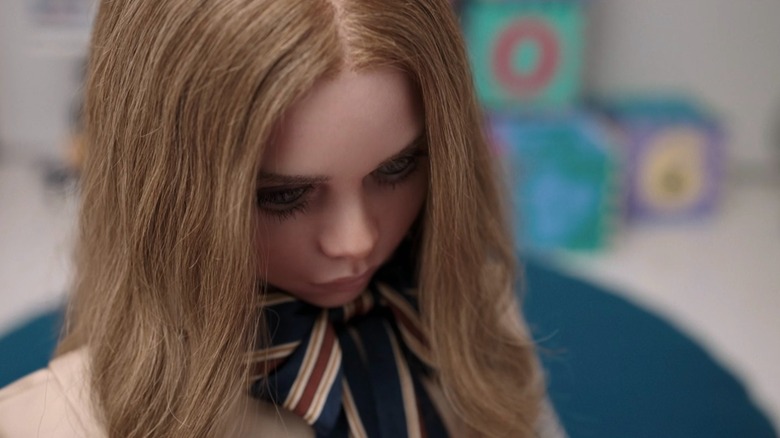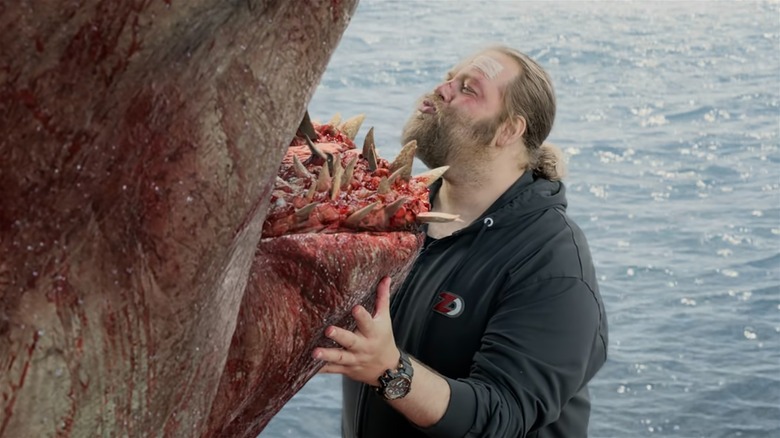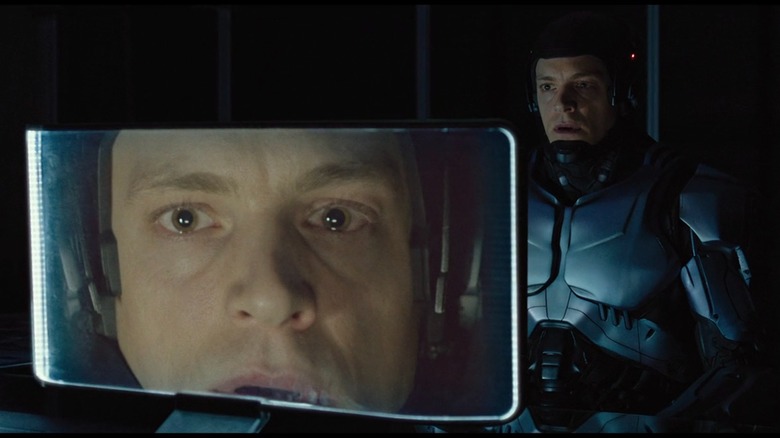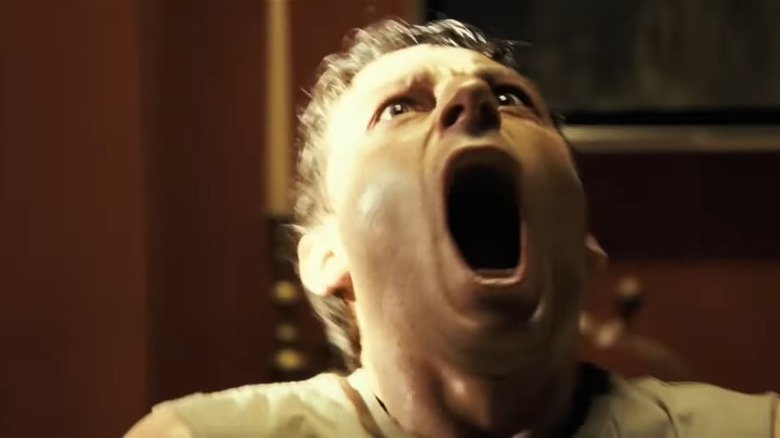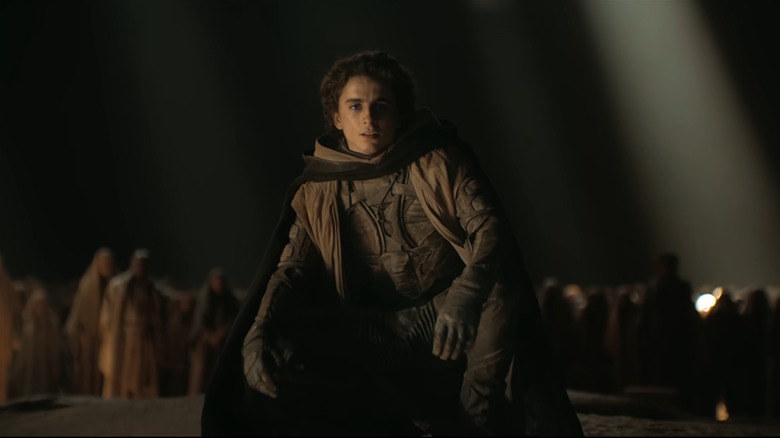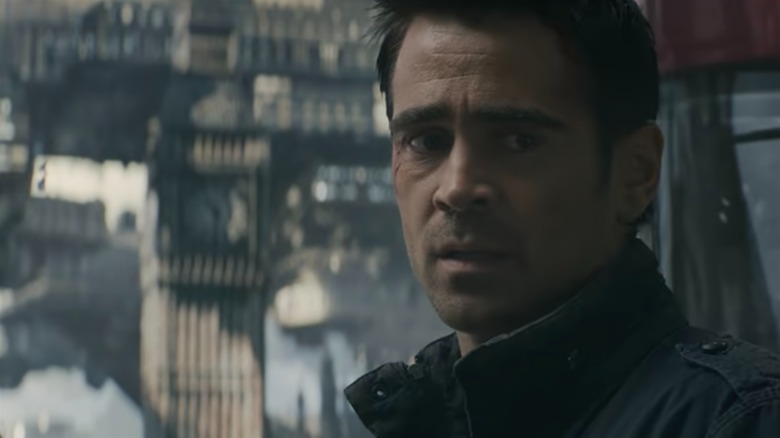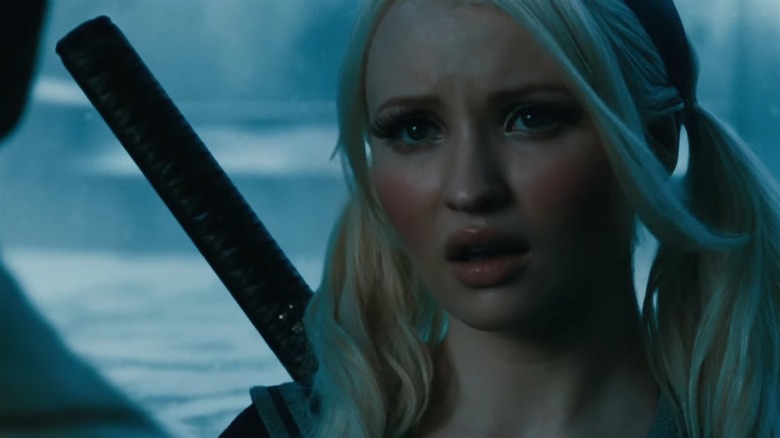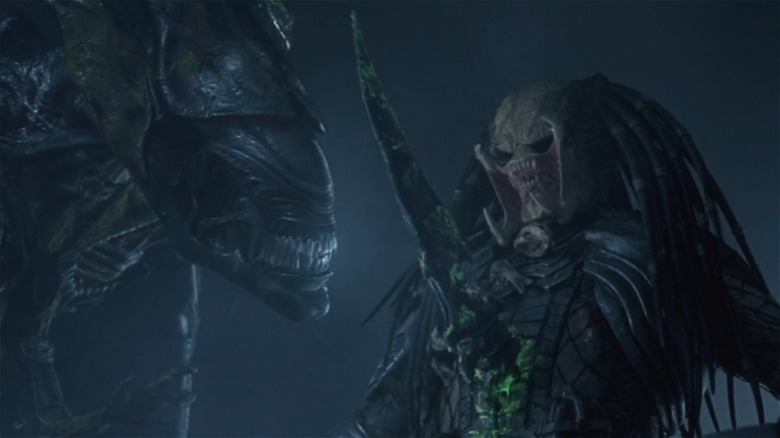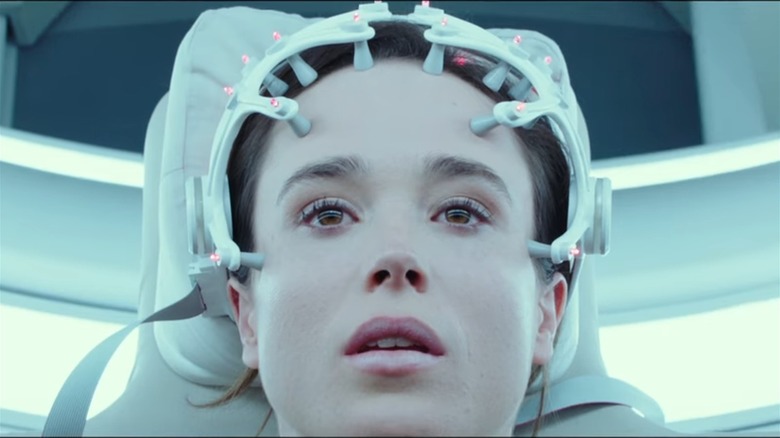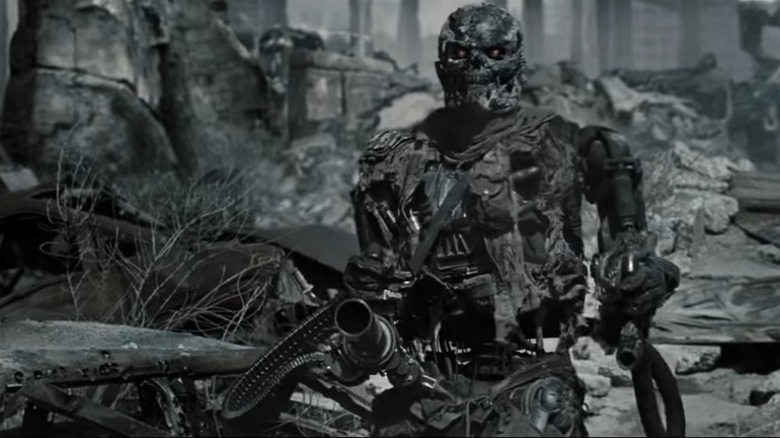Sci-Fi Movies That Should Have Been Rated R
When a film is looking to maximize its box office, there are numerous factors to consider. Some films rely on star power to draw audiences. Others attach themselves to recognizable properties, hoping familiar titles and characters will bring audiences back. Then there's the film's MPA (Motion Picture Association) rating. In 2018, the organization formerly known as the Motion Picture Association of America released a report noting that over half of all films were rated R, the most-adult, most-restrictive rating. Accordingly, in 2022, Axios reported that R-rated films were drawing a smaller portion of box office revenue than ever.
"If the greatest chance of box office success is having a PG-13 rating, or not having an R-rating, then that's where the industry really had to go," media analyst Paul Dergarabedian told the outlet. Still, he noted, there is often an audience for edgier fare, especially edgy genre fare. "Some of the best movies of all time have benefited from wearing the R rating as a badge of honor," Dergarabedian said. "Many horror (and action) films benefit from this harder-edged designation, which can often lead to greater success."
The same applies to science fiction movies, although studios often aren't willing to take the chance. Instead, we're left with disappointing films that would have been more interesting — or at least, more entertaining — if they had leaned into an R-rating, indulging in a little extra violence, profanity, and sexuality. All things considered, the sci-fi movies on this list really should have been rated R.
Frequency (2000)
In "Frequency," Dennis Quaid and Jim Caviezel play a father and son caught on either side of a thirty-year divide. Thanks to an opportune solar flare, something odd happens to the Northern Lights, and they're able to communicate across time using a ham radio. At first, John (Caviezel) warns his firefighter father Frank (Quaid) that he died in a warehouse blaze; thanks to that information, Frank's able to dodge danger. This changes the timeline, sending both men down a rabbit hole after a serial killer.
It's a solid film, but a tonally-strange one. For its first hour, "Frequency" focuses resolutely on the family angle, including several heartwarming montages of father and son playing baseball and loving one another despite their loss. When the timeline shifts, however, so does the tone. "Frequency" becomes a sort of sci-fi twist on the post-"Silence of the Lambs" cop dramas that were popular in the 1990s. Something about Frank living longer allows a serial killer called The Nightingale Killer to kill again, and in this timeline, John's mother Jules (Elizabeth Mitchell) is one of the victims.
Unfortunately, thanks in part to the film's PG-13 rating, the serial killer stuff lacks the tension that made those other cop dramas work so well. The killer is revealed almost immediately and the murders happen largely off-screen, rather than making the audience feel the danger. An R-rating could have made the serial killer subplot just as strong as the family drama, but as it stands, it feels uneven.
M3GAN (2023)
The internet fell in love with M3GAN, an evil dancing doll, from the moment the "M3GAN" trailer dropped. The movie is about a toymaker named Gemma (Allison Williams) who develops what she calls a "Model 3 Generative Android," or "M3GAN" for short. The doll imprints on her niece Cady (Violet McGraw), which it was supposed to do. But it wasn't, however, meant to go on a murderous rampage in an attempt to ensure that M3GAN is the only figure in Cady's life.
While the movie is a lot of fun, "M3GAN" is not particularly scary. Most of M3GAN's murders happen off screen, with the film often cutting away just as she really gets going. It's totally fine for a horror-comedy to lean heavily on the comedy side of things, but an R-rating could have helped elevate both aspects of the film. In fact, the "Unrated" cut of "M3GAN" does just that. We get to see more of the ear-pulling gore effect, and there's a lot more blood when M3GAN goes rogue at the toy company's headquarters. It's not only funnier when the film is willing to splatter itself in blood; it also highlights just how frightening it would be to get chased by a Sia-singing doll.
"M3GAN 2.0" is already in the works. Here's hoping the sequel is willing to push the envelope more than the first one did.
The Meg (2018)
Shark movies are supposed to be scary. "Jaws" works thanks to the incredible tension built by that iconic cello line, and while the beast is concealed for much of the film, it's not afraid to get violent when the shark does show up. It received a PG rating, but likely only because the creation of the PG-13 rating had't happened yet. These days, its nudity and terror would possibly warrant an R-rating.
"The Meg," on the other hand, is almost cartoonish. It's a movie about Jason Statham fighting a megalodon, a shark many times larger than the one in "Jaws." Instead of aiming for scares, though, the movie often goes for laughs instead. There are a couple of fun setpieces that work thanks to the sheer improbability of the Meg's size, but it never gets nearly as violent or gory as it should. Plus, to reiterate: this is a Jason Statham movie. He's one of our best cinematic foul-mouths, but he's not allowed to curse much thanks to the film's PG-13 rating.
Apparently, the film was originally much bloodier. However, director Jon Turtletaub decided not to move forward with an R-rated cut of "The Meg," reasoning that the movie was too much fun to exclude younger audiences. "I was very hesitant to cut out a lot of blood and gore," he told Bloody Disgusting. "I wouldn't have if I thought it was wrecking the story but it wasn't. It still looked okay." It's a shame they settled for "okay."
RoboCop (2014)
Paul Verhoeven's 1987 film "RoboCop" is an extremely bloody movie. The gleefully gory film is about an evil corporation that aims to privatize policing in a crime-ridden Detroit. To that end, they develop a new kind of cop: half-man and half-robot. He's a perfect propaganda tool, someone for Americans to idolize while he serves his corporate overlords. The ultra-violence elevates the satire; after all, America is a country built on bloodshed, and we love seeing it on screen even as the movie wants us to feel a little bit bad about that. Who can forget the film's iconic boardroom sequence, in which a man is absolutely shredded by bullets during a police drone demonstration gone wrong? Who can forget the scene toward the end where a man is submerged in toxic waste, causing his flesh to drip from his bones as he mutates beyond recognition?
The filmmakers behind the 2014 remake apparently forgot, because the movie updates neither iconic scene. Whereas the original "RoboCop" more than earned its R rating — even making cuts to avoid an X rating – the newer version is a sanitized, anesthetized PG-13. In the opening sequence, a robot shoots a kid, but the film immediately cuts away. Lots of gunfire follows, but bodies that are shot quickly drop out of frame. We never get to see the actual toll of violence on the human body, which is a crucial component of why the satirical spectacle of the original is so effective. It's an utter disappointment.
Passengers (2016)
In Morten Tyldum's "Passengers," Chris Pratt plays Jim, a cosmonaut traveling to the far reaches of space. When a malfunction wakes him from stasis 90 years too early, he decides to revive a fellow astronaut named Aurora (Jennifer Lawrence) for company. It's essentially an exercise in gaslighting, putting the man's need for companionship over the woman's right to not die on the spaceship long before completing her mission.
The PG-13 film seems hesitant to really engage with the misogynistic implications of its storyline. Jim isn't a good guy, and we're supposed to watch his seduction of Aurora with something like dread. At the same time, especially in 2016, Pratt and Lawrence are two of the most attractive movie stars of modern cinema, and the movie indulges in the inherent audience-pleasing spectacle of watching them trapped in a will-they, won't-they dance.
To make something productive out of that tension, the movie probably needed a different director. Someone like a Paul Verhoeven-type would have leaned into the seedy nature of the storyline, thrilling audiences with the dangerous sexuality of the plot while also making a commentary on its complicated gender dynamic. More overt, R-rated sexuality would have at least made the discourse around the resulting film more interesting, opening it up to reclamation by certain audiences willing to let a film indulge in that sort of thing. As it is, "Passengers" is mostly just forgettable.
The Fourth Kind (2009)
There's a lot to like about "The Fourth Kind," an eerie alien abduction thriller from 2009. The movie takes place in Nome, Alaska, a chilly town supposedly terrorized by the presence of aliens. Milla Jovovich plays Abbey Tyler, a researcher who travels to Nome to interview people who claim to have been visited by extraterrestrials. While there, she encounters compelling evidence that there might be something supernatural going on. Jovovich, a science fiction mainstay, is great, and in playing a scientist rather than an object of study, she almost inverts her "Resident Evil" persona.
Unfortunately, the movie is held back by its PG-13 rating. The horror sequences are edited frantically, often switching between normal cinematic filmmaking and a quasi-found footage approach. That means its most effective scenes are covered in a grainy, pixellated effect that can make the action difficult to parse. It's an intended effect, for the most part, but while the found-footage medium usually conveys authenticity, here the editing makes it unclear what we've actually just seen.
Instead, if the film had been rated R, it would have been able to linger on its more disturbing images rather than relying on jump scares. There must have been a way to preserve the doubt inherent in the investigation, while still making it clear that something very, very wrong is happening in Nome, Alaska.
Dune: Part Two (2024)
Denis Villeneuve's "Dune" films place us squarely inside the head of Paul Atreides (Timothée Chalamet), a young man who is told that it's his destiny to lead a rebellion. He fears that his actions will instead lead to a holy war, fretting that he will be responsible for a genocide rather than an actual uprising of freedom. In "Dune: Part Two," Paul finally confronts his destiny, embracing the prophecy that he is the messianic Lisan al Gaib.
Over the course of the films, we see several quick flashes of the violence to come. Paul has visions of a pile of burning corpses, and he understandably wants to avoid making that vision come true. In "Dune: Part Two," it finally does, but the scene is just as quick as his vision. Similarly, the film cuts away from a climactic battle sequence, quickly taking us inside a throne room rather than letting us see the chaos outside. The film is rated PG-13, and that has the unfortunate side effect of making the films skimp out on showing the true toll of the violence Paul unleashes on Arrakis.
The film is also short on sexuality. There's a quick post-sex scene between Paul and Chani (Zendaya), but they are both conspicuously filmed only from the neck up, breathing hard to indicate what's just gone on. It's a great film, and "Dune: Part Two" is also a sci-fi story for adults, but there should be no pressure to elide these very real facets of the human experience.
Total Recall (2012)
The 2012 version of "Total Recall" is another toothless remake of a Paul Verhoeven movie that does away with nearly everything that made the original so thrilling and audacious. Sure, the iconic woman with three breasts shows up, but otherwise, this is merely a serviceable sci-fi flick without any of the grit, character, and charisma that cemented the R-rated Verhoeven film as a classic.
In this version, Colin Farrell plays Douglas Quaid, a man who realizes his implanted memories might be fake. He might, in fact, be a spy. Farrell is a great actor, but he treats the material too seriously. Arnold Schwarzenegger, on the other hand, knew how to add a wink into his performance. Schwarzenegger has great on-screen chemistry with Sharon Stone, but Farrell, on the other hand, gets paired with Jessica Biel, and it's as limp as the PG-13 rating would suggest.
The film's world-building is also disappointing. Verhoeven's vision of life on Mars was constructed with largely practical effects, while remake director Len Wiseman sets his action mostly on Earth and builds out his environments with weightless-looking CGI. A story like this needs the sordid vulgarity of Verhoeven's touch, full of exploding squib packs and people being ripped limb from limb. Instead, this remake is largely bloodless, and it's clear that something is missing. It's a fine-enough movie, but it's just not nearly as fun as it should be.
Sucker Punch (2011)
Zack Snyder's 2011 film "Sucker Punch" is an odd one. It's a movie about a group of girls who are kept in a mental hospital, and it almost operates on video game logic. Babydoll (Emily Browning) goes on a series of quests to find items that will help her escape, and she fantasizes about (or travels to?) alternate realities where she's a fighter. Her friends have names like Blondie (Vanessa Hudgens), Sweet Pea (Abbie Cornish), and Rocket (Jena Malone), and together they battle against the evil men working to strip them of their agency.
In its theatrical form, "Sucker Punch" toes the line between being misogynistic, and being a movie about misogyny. It revels in fan-service shots of beautiful women in skimpy, impractical fighting costumes, but it's also about women weaponizing the male gaze to regain some semblance of empowerment over men.
Like many Snyder movies, this logic is sometimes difficult to follow. Also like many Snyder movies, studio-mandated cuts were responsible. The extended cut of "Sucker Punch" is a much better movie because it makes its storyline explicit: the men in charge are trying to sell Babydoll's virginity, something only implied in the theatrical version. That's an uncomfortable thing for a movie to be about, and "Sucker Punch" is stronger when it confronts those themes head-on, rather than trying to dodge them to secure a PG-13 rating.
Alien vs. Predator (2004)
Franchise crossover films have the unenviable task of meeting the expectations of fans of both franchises, delivering something new while maintaining the spirit of the films that came before. "Freddy vs. Jason" does that by committing to being a "Nightmare on Elm Street" movie, one that also happens to feature a particularly badass Jason Voorhees. "Alien vs. Predator," on the other hand, satisfies nobody by being something else entirely. Namely, it's bad.
A head-to-head matchup between two of action/horror/sci-fi cinema's most iconic bad guys should have been an exciting event, but the movie is a disappointment from start to finish thanks to its defanged, CGI-heavy, PG-13 approach. Every other "Predator" movie had been rated R, as was every other "Alien" movie. They're all bloody and frightening films, full of gruesome deaths and practical effects that make the monsters seem real. In "AvP," on the other hand, the Xenomorph is made of weightless CGI effects that are barely better than the creature in "Species," which is incidentally worth watching anyway. It's hard to be concerned for the alien, the Predator, or any of the film's many human characters when everything looks so flat and uninspired.
Perhaps we should've known what we were in for thanks to the film's poster. The tagline reads, "Whoever wins... we lose," and ain't that the truth.
Flatliners (2017)
The original "Flatliners," a film from 1990, features a hot young cast including Kiefer Sutherland, Kevin Bacon, Julia Roberts, and William Baldwin. It's about a group of students who discover a way to engineer near-death experiences, allowing each other to "flatline" and journey beyond death before being revived. It's nothing fantastic, but it's a serviceably spooky film. Even without the usually-effective horror sequences, the film crackles with energy thanks to an at-times-uncomfortable sexual tension among several members of the cast.
In 2017, the film was rebooted with a movie that serves as both sequel and remake. This time, it was rated PG-13. Accordingly, the horror sequences are lame, butchered in the edit to the point of being nearly incomprehensible. The film can't seem to make up its mind about whether the visions experienced by the students are paranormal apparitions or manifestations of guilt. The sexual tension is almost entirely absent, too, even though the cast is again full of attractive young actors like Diego Luna, Nina Dobrev, Elliot Page, and Kiersey Clemons.
It's all far too self-serious, whereas the original let itself revel a bit in the psychosexual implications of its central conceit. One leaves the 2017 version of "Flatliners" wondering what the point was. Why bother remaking a not-great film if you're going to intentionally make it less interesting?
Terminator Salvation (2009)
Simply put, the "Terminator" franchise is a mess. The first two are fantastic, and they're just a couple reasons you should never bet against James Cameron. After that, though, things went sideways. "Terminator 3: Rise of the Machines" was rated R, but it still felt too anodyne compared to the brawny physicality of the first two installments. Then came 2009's "Terminator Salvation," the first franchise entry to be rated PG-13. It's also the first entry that takes place entirely in the future, depicting the war between humanity and Skynet. That should be cause for more brutal, bloody mayhem than ever before, but instead, this one feels positively tame.
In the future world of "Terminator Salvation," Christian Bale plays a grown-up John Connor. We're meant to believe that this is the future that Arnold Schwarzenegger's Terminator traveled back in time to prevent, accidentally ensuring its survival thanks to Kyle Reese (Michael Biehn) hot on his tail. This time, Kyle Reese is played by the late Anton Yelchin, and the idea that Yelchin is Bale's father stretches suspension of disbelief past its breaking point.
This was also supposed to be the first "Terminator" film without Schwarzenegger, but director McG couldn't resist including a digital replica of young Schwarzenegger's face on a T-800. It's the perfect metaphor for the film's failures as a whole: a thin, CGI-heavy imitation dressed up in the skin of a beloved film, but missing the living, breathing humanity that made the original work.
